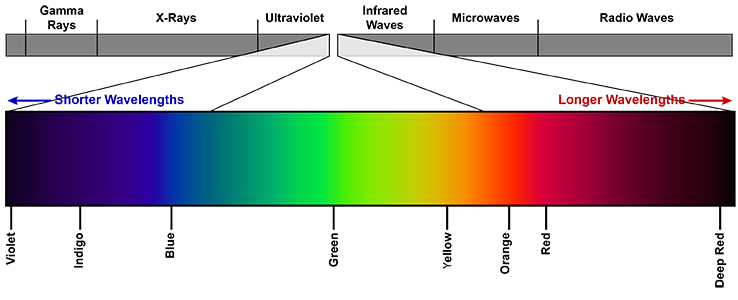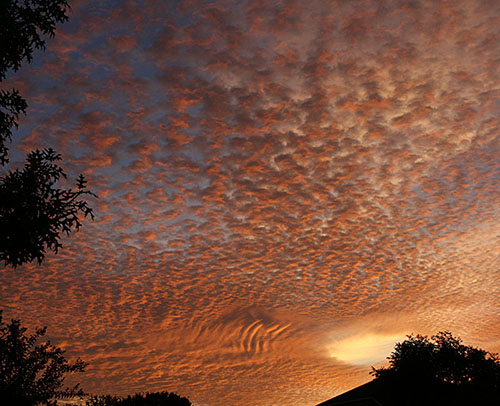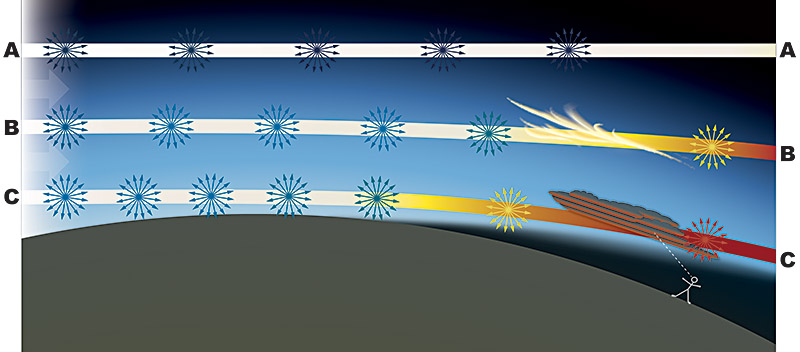The color of a cloud depends primarily upon the color of the light it receives. The Earth's natural source of light is the Sun which provides white light. White light combines all of the colors in the visible spectrum, which is the range of colors we can see.
Each color in the visible spectrum represents electromagnetic waves of differing lengths. As the wavelength increases, the colors change from violet to indigo to blue, green, yellow, orange, red, and deep red.

As a light wave's length increases, its energy decreases. This means the light waves that make up violet, indigo, and blue have higher energy levels than the yellow, orange, and red.
One way to see the colors of sunlight is by the use of a prism. The velocity of light decreases slightly as it moves into the prism, causing it to bend slightly. This is called refraction. The degree of refraction varies with the energy level each wave.
The lowest energy light waves refract the least, while the highest energy waves exhibit the greatest refraction. The end result is a dispersion of light into a rainbow of colors.
Rainbows are partly the result of sunlight refraction through a rain drop, which acts like a prism.

If sunlight is white, why is the sky blue?
The color of the sky is a result of light bouncing off gasses in the atmosphere in what is called Rayleigh scattering, named after physicist Lord Rayleigh.
The atoms and molecules comprising the atmospheric gasses are much smaller than the wavelengths of light emitted by the sun. As a result, collisions cause the relatively larger wavelengths to scatter unequally, with shorter wavelengths scattering more than longer ones.
As sunlight enters the atmosphere, much of the short violet light waves scatter first, but very high in the atmosphere and therefore not readily seen. Indigo light waves scatter next and can be seen from high altitudes such as from jet airplanes flying at normal cruising altitudes.
Blue light waves scatter next, at a rate about four times stronger than red light waves. The volume of scattering by the shorter blue light waves, along with additional scattering by violet and indigo, dominate scattering by the remaining color wavelengths. Therefore, we primarily perceive the blue light as the color of the sky.

If the sky is blue, why are clouds white?
Unlike Rayleigh scattering, where the light waves are larger than the gas molecules in the atmosphere, the individual water droplets that make up a cloud are of similar size to the wavelength of sunlight. When the droplets and light waves are of similar size, a different type of scattering, called Mie scattering, occurs.
Mie scattering does not differentiate individual wavelength colors and, therefore, scatters all wavelengths of color the same. We perceive this equally-scattered light as white.
However, clouds do not always appear white. Haze and dust in the atmosphere can cause them to appear yellow, orange, or red. As clouds thicken, sunlight passing through them will diminish or be blocked, giving the cloud a gray color. If there is no direct sunlight striking the cloud, it may even reflect the color of the sky and appear bluish.
Rayleigh and Mie
Some of the most picturesque clouds occur close to sunrise and sunset, when they appear in brilliant yellows, oranges, and reds. The colors result from a combination of Rayleigh and Mie scattering.
At sunrise and sunset, the Sun is low in the sky, and its light passes close to the Earth’s surface where the atmosphere is most dense. As light enters the atmosphere at this angle, it refracts with the greatest bend due to this higher density, causing the light's path to lengthen, further allowing for more Rayleigh scattering.
Most of the shorter blue wavelengths are scattered on this longer path, leaving the majority of longer waves to continue. As light continues to move through the atmosphere, yellow wavelengths are scattered leaving orange wavelengths. Further scattering of orange wavelengths leaves red as the predominant color of sunlight.
Therefore, near sunrise and sunset, a cloud's color will be whatever sunlight color it receives after Rayleigh scattering. Mei scattering scatters all remaining wavelength colors equally within the cloud.

The Color of Perception
Sometimes, under direct sunlight, clouds will appear gray or dark gray against a blue sky or larger backdrop of white clouds. There are usually two reasons for this effect.
- The clouds may be semi-transparent which allows the background blue sky to be seen through the cloud, thereby giving it a darker appearance.
- More commonly, the contrast between the background (blue sky or additional clouds) and the foreground cloud overwhelms our vision. In essence, the overwhelming brightness of the background tricks our eyes into perceiving the relatively darker foreground clouds as gray.


